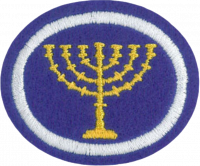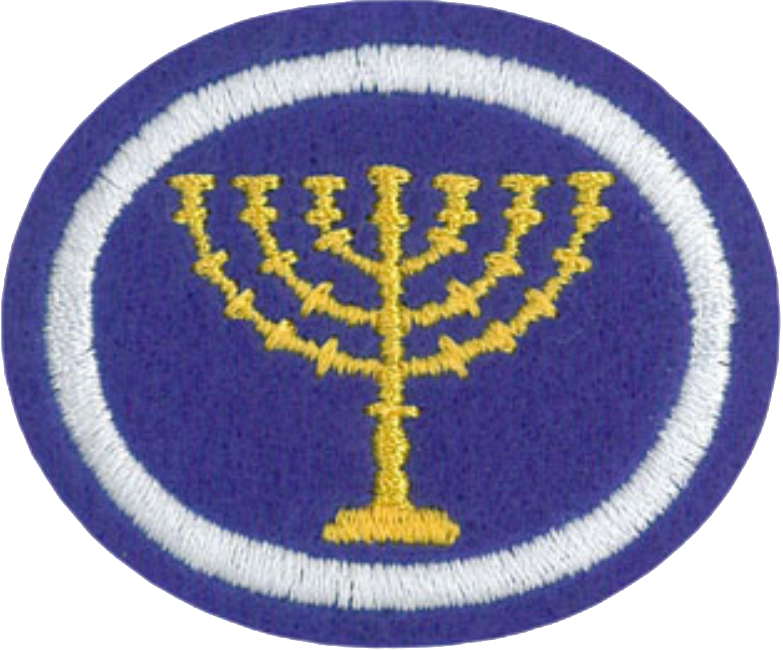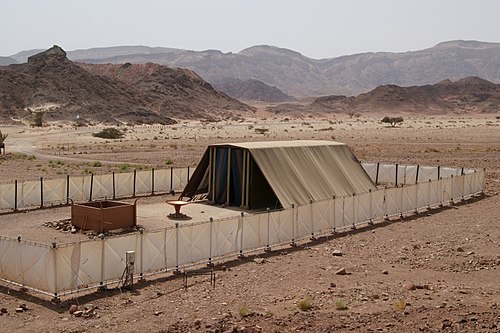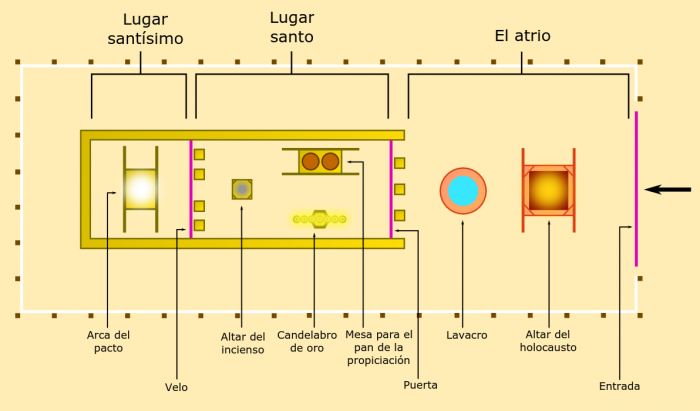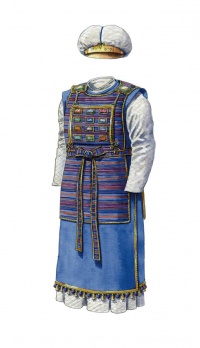Difference between revisions of "AY Honors/Sanctuary/Answer Key/es"
(Created page with "</noinclude> <!-- 2. Dibujar un modelo a escala del santuario, el atrio y la posición de todo el mobiliario (no olvidar de añadir las direcciones cardinales). --> File:T...") |
(Created page with "</noinclude> Los sacerdotes usaban calzoncillos de lino como ropa interior. Las vestiduras eran tejidas de una sola pieza, impecable y sin ninguna mancha. Todos los sacerdotes...") |
||
| Line 88: | Line 88: | ||
<noinclude></noinclude> | <noinclude></noinclude> | ||
{{ansreq|page={{#titleparts:{{PAGENAME}}|2|1}}|num=3a}} | {{ansreq|page={{#titleparts:{{PAGENAME}}|2|1}}|num=3a}} | ||
| − | <noinclude> | + | <noinclude></noinclude> |
| − | </noinclude> | + | Éxodo 26 |
| − | |||
| − | |||
| − | |||
| − | |||
| − | |||
| − | |||
| − | + | <noinclude></noinclude> | |
| − | <noinclude | ||
| − | |||
{{CloseReq}} <!-- 3a --> | {{CloseReq}} <!-- 3a --> | ||
{{ansreq|page={{#titleparts:{{PAGENAME}}|2|1}}|num=3b}} <!--T:3b--> | {{ansreq|page={{#titleparts:{{PAGENAME}}|2|1}}|num=3b}} <!--T:3b--> | ||
| − | <noinclude> | + | <noinclude></noinclude> |
| − | </noinclude | ||
| − | |||
| − | |||
| − | |||
| − | |||
| − | |||
| − | + | Los significados a continuación han sido tomados de la Concordancia Temática Strong de la Reina Valera, a menos que se indique lo contrario: | |
| − | <noinclude | + | |
| − | + | # Forro real interior: | |
| + | #* Lino representa limpieza, justicia ({{Bible link/es|Apocalipsis 19:8}}) | ||
| + | #* Lino representa limpieza, pureza ({{Bible link/es|Apocalipsis 19:14}}) | ||
| + | #* Para el significado de los colores (rojo, azul, púrpura, dorado) ver la siguiente sección. | ||
| + | # Pelo de cabra | ||
| + | #* Alimento ({{Bible link/es|Génesis 27:9}}) | ||
| + | #* Leche ({{Bible link/es|Proverbios 27:27}}) | ||
| + | #* Ropa ({{Bible link/es|Números 31:20}}) | ||
| + | #* Pago ({{Bible link/es|Génesis 38:17:-23}}) | ||
| + | #* Ofrenda ({{Bible link/es|Jueces 13:15,19}}) | ||
| + | #* Sacrifico de Pascua ({{Bible link/es|Éxodo 12:5}}) | ||
| + | #* Ofrenda por el pecado ({{Bible link/es|Levítico 4:23}}) | ||
| + | #* Representa liderazgo ({{Bible link/es|Jeremías 50:8}}) | ||
| + | #* Representa debilidad física ({{Bible link/es|Jueces 14:6}}) | ||
| + | #* Representa malvados ({{Bible link/es|Mateo 25:32-33}}) | ||
| + | # Piel de carnero | ||
| + | #* Alimento ({{Bible link/es|Génesis 31:38}}) | ||
| + | #* Sustituto dado por Dios ({{Bible link/es|Génesis 22:13}}) | ||
| + | #* Ofrenda por el pecado ({{Bible link/es|Levítico 5:15}}) | ||
| + | #* Cuernos usados como trompetas ({{Bible link/es|Josué 6:4-13}}) | ||
| + | #; Teñido de rojo | ||
| + | #* Túnica de José teñida de sangre ({{Bible link/es|Génesis 37:31}}) | ||
| + | #* Ropa de Cristo teñida de sangre ({{Bible link/es|Apocalipsis 19:13}}) | ||
| + | # Toldo de cuero ("tejón") | ||
| + | #* Usado como calzado ({{Bible link/es|Ezequiel 16:10}}) | ||
| + | #; Otros significados | ||
| + | #* Cubría los atractivos internos del tabernáculo ({{Bible link/es|Isaías 53:2}}) | ||
| + | |||
| + | <noinclude></noinclude> | ||
{{CloseReq}} <!-- 3b --> | {{CloseReq}} <!-- 3b --> | ||
{{CloseReq}} <!-- 3 --> | {{CloseReq}} <!-- 3 --> | ||
{{ansreq|page={{#titleparts:{{PAGENAME}}|2|1}}|num=4}} | {{ansreq|page={{#titleparts:{{PAGENAME}}|2|1}}|num=4}} | ||
| − | <noinclude>< | + | <noinclude><!-- 4. Los siguientes fueron los colores utilizados en el santuario y en las prendas de vestir de los sacerdotes. Explicar lo que representa cada color. --> |
| − | </ | + | Los significados a continuación han sido tomados de la Concordancia Temática Strong de la Reina Valera, a menos que se indique lo contrario: |
| − | < | + | |
| − | + | ===a. <span style="color:red">Rojo</span>=== | |
| − | </ | + | ; <span style="color:red">Rojo, grana, escarlata, carmesí, enrojecido</span> |
| + | * Expiación ({{Bible link/es|Isaías 63:1-3}}) | ||
| + | * Poder militar ({{Bible link/es|Nahúm 2:3}}) | ||
| + | * Persecusión ({{Bible link/es|Apocalipsis 12:3; 17:3-4}}) | ||
| + | * Embriaguez ({{Bible link/es|Proverbios 23:29}}) | ||
| + | * Pecaminosidad ({{Bible link/es|Isaías 1:18}}) | ||
| + | ; <span style="color:red">Otros significados</span> | ||
| + | * Sacrificio ({{Bible link/es|Levítico 14:4}}) | ||
| + | * Pacto ({{Bible link/es|Josué 2:18}}) | ||
| + | |||
| + | ===b. <span style="color:blue">Azul</span>=== | ||
| + | |||
| + | ; <span style="color:blue">Azul, zafiro</span> | ||
| + | * - | ||
| + | ; <span style="color:blue">Otros significados</span> | ||
| + | * Obediencia ({{Bible link/es|Números 15:38-39}}) | ||
| + | * Presencia de Dios ({{Bible link/es|Éxodo 24:10-11; Ezequiel 1:26; 10:1}}) | ||
| + | |||
| + | ===c. <span style="color:purple">Púrpura</span>=== | ||
| + | |||
| + | ; <span style="color:purple">Púrpura</span> | ||
| + | * Realeza ({{Bible link/es|Jueces 8:26; Marcos 15:16-18; Juan 19:2,5}}) | ||
| + | * Riqueza ({{Bible link/es|Lucas 16:19}}) | ||
| + | |||
| + | ===d. <span style="color: white;text-shadow:-1px -1px 0 #000,1px -1px 0 #000,-1px 1px 0 #000, 1px 1px 0 #000;">Blanco</span>=== | ||
| + | |||
| + | ; <span style="color: white;text-shadow:-1px -1px 0 #000,1px -1px 0 #000,-1px 1px 0 #000, 1px 1px 0 #000;">Blanco, limpio, resplandeciente</span> | ||
| + | * Gloria y majestad ({{Bible link/es|Daniel 7:9; Apocalipsis 1:14; 20:11}}) | ||
| + | * Victoria ({{Bible link/es|Apocalipsis 6:2; 19:11,14-15}}) | ||
| + | * Finalización ({{Bible link/es|Juan 4:35}}) | ||
| + | ; <span style="color: white;text-shadow:-1px -1px 0 #000,1px -1px 0 #000,-1px 1px 0 #000, 1px 1px 0 #000;">Otros significados</span> | ||
| + | * Justicia, pureza ({{Bible link/es|Apocalipsis 19:8}}) | ||
| + | |||
| + | ===e. Negro=== | ||
| − | + | ; Negro, oscuridad, tinieblas | |
| − | + | * Calamidad ({{Bible link/es|Apocalipsis 6:4-6,12}}) | |
| − | + | * Castigo final ({{Bible link/es|Judas 1:13}}) | |
| + | ; Otros significados | ||
| + | * Sin Dios ({{Bible link/es|1 John 1:5}}) | ||
| + | * Ignorancia ({{Bible link/es|Juan 12:35; Romanos 2:19; 1 Juan 2:8-9}}) | ||
| − | + | ===f. <span style="color:gold">Dorado</span>=== | |
| − | |||
| − | |||
| − | < | + | ; <span style="color:gold">Oro</span> |
| − | + | * - | |
| − | + | ; <span style="color:gold">Otros significados</span> | |
| + | * Presencia de Dios ({{Bible link/es|Job 22:25}}) | ||
| − | + | ===g. <span style="color:silver">Plateado</span>=== | |
| − | |||
| − | |||
| − | < | + | ; <span style="color:silver">Plata</span> |
| − | ''' | + | * - |
| − | + | ; <span style="color:silver">Otros significados</span> | |
| + | * Redención ({{Bible link/es|Éxodo 30:15}}) | ||
| + | * Deseo, anhelo - La palabra hebrea para ''anhelo'' (kāsap) comparte una raíz con la palabra hebrea para ''plata'' (kesap). | ||
| − | + | ===h. <span style="color:#CD7F32">Bronceado</span>=== | |
| − | |||
| − | </ | ||
| − | < | + | ; <span style="color:#CD7F32">Bronce</span> |
| − | + | * - | |
| − | + | ; <span style="color:#CD7F32">Otros significados</span> | |
| + | * Encarnación, muerte de Cristo ({{Bible link/es|Números 21:9; Juan 3:13-14}}) | ||
| − | + | <noinclude></noinclude> | |
| − | <noinclude | ||
| − | |||
{{CloseReq}} <!-- 4 --> | {{CloseReq}} <!-- 4 --> | ||
{{ansreq|page={{#titleparts:{{PAGENAME}}|2|1}}|num=5}} | {{ansreq|page={{#titleparts:{{PAGENAME}}|2|1}}|num=5}} | ||
| − | <noinclude> | + | <noinclude></noinclude> |
| − | </noinclude> | + | <!-- 5. Discutir y memorizar 1 Juan 1:9; Daniel 8:14; Éxodo 25:8 --> |
| − | <!-- 5. | + | |
{{Bible verse | {{Bible verse | ||
| − | | book = 1 | + | | book = 1 Juan |
| chapter = 1 | | chapter = 1 | ||
| verse = 9 | | verse = 9 | ||
| − | | version = | + | | version = RVR1995 |
| − | | text = | + | | text = Si confesamos nuestros pecados, él es fiel y justo para perdonar nuestros pecados y limpiarnos de toda maldad. |
| − | |||
}} | }} | ||
| − | |||
| − | |||
{{Bible verse | {{Bible verse | ||
| book = Daniel | | book = Daniel | ||
| chapter = 8 | | chapter = 8 | ||
| verse = 14 | | verse = 14 | ||
| − | | version = | + | | version = RVR1995 |
| − | | text = | + | | text = Y él dijo: “Hasta dos mil trescientas tardes y mañanas; luego el santuario será purificado.” |
| − | |||
}} | }} | ||
| − | |||
| − | |||
{{Bible verse | {{Bible verse | ||
| − | | book = | + | | book = Éxodo |
| chapter = 25 | | chapter = 25 | ||
| verse = 8 | | verse = 8 | ||
| − | | version = | + | | version = RVR1995 |
| − | | text = | + | | text = Me erigirán un santuario, y habitaré en medio de ellos. |
| − | |||
}} | }} | ||
| − | |||
| − | + | <noinclude></noinclude> | |
| − | <noinclude | ||
| − | |||
{{CloseReq}} <!-- 5 --> | {{CloseReq}} <!-- 5 --> | ||
{{ansreq|page={{#titleparts:{{PAGENAME}}|2|1}}|num=6}} | {{ansreq|page={{#titleparts:{{PAGENAME}}|2|1}}|num=6}} | ||
| − | <noinclude> | + | <noinclude></noinclude> |
| − | </noinclude> | + | <!-- 6. ¿De cuál de las 12 tribus eran los sacerdotes? ¿Por qué? --> |
| − | <!-- 6. | ||
| − | |||
| − | |||
| − | |||
| − | |||
| − | |||
| − | |||
| − | |||
| − | |||
| − | |||
| − | |||
| − | |||
| − | + | <noinclude></noinclude> | |
| − | <noinclude | ||
| − | |||
{{CloseReq}} <!-- 6 --> | {{CloseReq}} <!-- 6 --> | ||
{{ansreq|page={{#titleparts:{{PAGENAME}}|2|1}}|num=7}} | {{ansreq|page={{#titleparts:{{PAGENAME}}|2|1}}|num=7}} | ||
| − | <noinclude> | + | <noinclude></noinclude> |
| − | </noinclude> | + | <!-- 7. Describir la túnica de: --> |
| − | <!-- 7. | + | <noinclude></noinclude> |
| − | <noinclude | ||
| − | |||
{{ansreq|page={{#titleparts:{{PAGENAME}}|2|1}}|num=7a}} | {{ansreq|page={{#titleparts:{{PAGENAME}}|2|1}}|num=7a}} | ||
| − | <noinclude> | + | <noinclude></noinclude> |
| − | </noinclude> | + | Los sacerdotes usaban calzoncillos de lino como ropa interior. Las vestiduras eran tejidas de una sola pieza, impecable y sin ninguna mancha. Todos los sacerdotes comunes vestían una túnica y un turbante de lino blanco sencillo. Siempre removían sus sandalias antes de entrar al Santuario ({{bible link/es| Éxodo 28; 39}}). |
| − | |||
| − | |||
| − | + | <noinclude></noinclude> | |
| − | <noinclude | ||
| − | |||
{{CloseReq}} <!-- 7a --> | {{CloseReq}} <!-- 7a --> | ||
{{ansreq|page={{#titleparts:{{PAGENAME}}|2|1}}|num=7b}} <!--T:7b--> | {{ansreq|page={{#titleparts:{{PAGENAME}}|2|1}}|num=7b}} <!--T:7b--> | ||
| − | <noinclude> | + | <noinclude></noinclude> |
| − | </noinclude> | + | [[File:Illustration-high-priest-garments.jpg|thumb|200px|Vestimentas sagradas judías del sumo sacerdote]] |
| − | [[File: | + | |
| − | + | Como todos los sacerdotes, el sumo sacerdote usaba calzoncillos de lino como ropa interior. Las prendas eran tejidas tejen de una pieza, impecable, sin ningún defecto. Sobre la ropa interior, llevaba una capa de lino bordada, otra vez tejido de una pieza de tela. El abrigo estaba atado con una faja bordada. Sobre esto el sumo sacerdote llevaba una sola pieza sin mangas de manto azul sólido. En el dobladillo de la túnica azul colgaba pequeñas tintineantes campanas de oro y granadas brillantes. | |
| − | |||
| − | + | El efod, fue usado fuera de la túnica azul-una prenda más corta de oro, azul, púrpura y escarlata, y la multa de lino trenzado. El efod fue atado en los hombros con dos piedras del Onyx, en cada uno fue grabado los nombres de seises de las tribus de Israel. En el efod el sumo sacerdote llevaba una coraza hecha de dos piezas de tela sujetas juntas. En la coraza, junto al corazón del sumo sacerdote, se encontraban dos piedras de ónice llamadas Urim y Tumim, a través de las cuales Dios hizo conocer su voluntad. | |
| − | |||
| − | |||
| − | + | En el exterior del peto había 12 piedras preciosas. Fueron arreglados como cuatro filas de tres. Su secuencia, de izquierda a derecha y de arriba a abajo fueron: Sardis (rojo pardusco), Topaz (amarillo al rojo amarillento), ántrax (rojo), esmeralda (verde claro), zafiro (azul profundo), diamante (claro chispeante), Jacinto (amarillo brillante), ágata (azul delicado), amatista (violeta), Beryl (verde-amarillo), Onyx (amarillo brillante), jaspe (rojo, marrón, o amarillo). | |
| − | |||
| − | |||
| − | + | Llevaba una mitra (una corona) en la cabeza. Atado a la vanguardia de la misma con una cinta de color azul, era un plato de oro puro en el que se grabó la inscripción 'Santidad al Señor ' ({{bible link | Éxodo 28; 39}}) | |
| − | |||
| − | |||
| − | |||
| − | + | <noinclude></noinclude> | |
| − | <noinclude | ||
| − | |||
{{CloseReq}} <!-- 7b --> | {{CloseReq}} <!-- 7b --> | ||
{{CloseReq}} <!-- 7 --> | {{CloseReq}} <!-- 7 --> | ||
{{ansreq|page={{#titleparts:{{PAGENAME}}|2|1}}|num=8}} | {{ansreq|page={{#titleparts:{{PAGENAME}}|2|1}}|num=8}} | ||
| − | <noinclude> | + | <noinclude></noinclude> |
| − | </noinclude> | + | <!-- 8. Leer y debatir El Conflicto de los Siglos, página 479, y Hebreos 4:14-16. --> |
| − | <!-- 8. | ||
| − | |||
| − | + | {{clear}} | |
| − | {{ | ||
| − | |||
| − | |||
| − | |||
| − | |||
| − | |||
| − | |||
| − | |||
| − | + | {{clear}} | |
| − | |||
| − | |||
| − | |||
{{Bible verse | {{Bible verse | ||
| − | | book = | + | | book = Hebreos |
| chapter = 4 | | chapter = 4 | ||
| verse = 14-16 | | verse = 14-16 | ||
| − | | version = | + | | version = RVR1995 |
| text = | | text = | ||
| − | <sup>14</sup> | + | «<sup>14</sup> Por tanto, teniendo un gran Sumo sacerdote que traspasó los cielos, Jesús el Hijo de Dios, retengamos nuestra profesión. <sup>15</sup> No tenemos un sumo sacerdote que no pueda compadecerse de nuestras debilidades, sino uno que fue tentado en todo según nuestra semejanza, pero sin pecado. <sup>16</sup> Acerquémonos, pues, confiadamente al trono de la gracia, para alcanzar misericordia y hallar gracia para el oportuno socorro.» |
}} | }} | ||
| − | |||
| − | + | <noinclude></noinclude> | |
| − | <noinclude | ||
| − | |||
{{CloseReq}} <!-- 8 --> | {{CloseReq}} <!-- 8 --> | ||
{{ansreq|page={{#titleparts:{{PAGENAME}}|2|1}}|num=9}} | {{ansreq|page={{#titleparts:{{PAGENAME}}|2|1}}|num=9}} | ||
| − | <noinclude> | + | <noinclude></noinclude> |
| − | </noinclude> | + | <!-- 9. ¿Qué clase de animales eran llevados al atrio a diario? --> |
| − | <!-- 9. | + | |
| − | + | Un toro joven, carneros, vaquillas, corderos, cabras, palomas o palomas eran llevados diariamente al Santuario. Todos estaban ceremonialmente limpios, sin mancha alguna. | |
| − | |||
| − | + | <noinclude></noinclude> | |
| − | <noinclude | ||
| − | |||
{{CloseReq}} <!-- 9 --> | {{CloseReq}} <!-- 9 --> | ||
{{ansreq|page={{#titleparts:{{PAGENAME}}|2|1}}|num=10}} | {{ansreq|page={{#titleparts:{{PAGENAME}}|2|1}}|num=10}} | ||
| − | <noinclude> | + | <noinclude></noinclude> |
| − | </noinclude> | + | <!-- 10. Escribir un párrafo o decir cómo ve a Cristo representado en el santuario y los servicios. --> |
| − | <!-- 10. | ||
| − | |||
| − | + | Después de estudiar esta especialidad, esto debe ser fácil. | |
| − | + | <noinclude></noinclude> | |
| − | <noinclude | ||
| − | |||
{{CloseReq}} <!-- 10 --> | {{CloseReq}} <!-- 10 --> | ||
| − | <noinclude> | + | <noinclude></noinclude> |
| − | </noinclude> | + | ==Referencias== |
| − | == | + | <noinclude></noinclude> |
| − | <noinclude | ||
| − | |||
[[Category:AY Honors/noindex{{GetLangSuffix}}|{{SUBPAGENAME}}]] | [[Category:AY Honors/noindex{{GetLangSuffix}}|{{SUBPAGENAME}}]] | ||
{{CloseHonorPage}} | {{CloseHonorPage}} | ||
Latest revision as of 01:36, 10 March 2023
Nivel de destreza
2
Año
2004
Version
07.10.2025
Autoridad de aprobación
División Norteamericana
1
Las tres secciones principales del santuario eran el atrio, el lugar santo y el lugar santísimo.
1a
- El atrio:
- El altar del holocausto
- El lavacro
- Lugar santo:
- La mesa para el pan de la propiciación
- El candelabro de oro
- El altar del incienso
- Lugar santísimo:
- El arca del pacto
1b
- Altar del holocausto:
- Sacrificio de Cristo (Template:Bible link/es)
- Cordero
- Jesús (Template:Bible link/es)
- Sacrificios espirituales (Template:Bible link/es)
- Culto (Template:Bible link/es)
- Alabanza (Template:Bible link/es)
- Compasión (Template:Bible link/es)
- Servicio (Template:Bible link/es)
- Sacrificio de Cristo (Template:Bible link/es)
- Fuente / Lavacro:
- Limpieza
- Limpieza del pecado (Template:Bible link/es)
- Agua
- Biblia (Template:Bible link/es)
- Bautismo (Template:Bible link/es)
- Mesa para el pan de la propiciación:
- Comunión íntima (Template:Bible link/es)
- Cena del Señor (Template:Bible link/es)
- Pan
- Cristo, el pan de vida (Template:Bible link/es)
- Biblia (Template:Bible link/es)
- Número 12
- Los Cristianos dan a conocer la voluntad de Dios (Template:Bible link/es)
- Candelero de oro:
- Luz
- Cristo, la Luz del mundo (Template:Bible link/es)
- Cristianos / Iglesia (Template:Bible link/es)
- Aceite
- Espíritu Santo (Template:Bible link/es)
- Lámpara
- Biblia (Template:Bible link/es)
- Altar del incienso:
- Incienso
- Oración (Template:Bible link/es)
- Compasión (Template:Bible link/es)
- Intercesión
- Las oraciones ascienden a los cielos, por la intercesión y los méritos de Jesús (Template:Bible link/es)
- Arca del pacto:
- La presencia de Dios (los 10 Mandamientos)
2
3
3a
Éxodo 26
3b
Los significados a continuación han sido tomados de la Concordancia Temática Strong de la Reina Valera, a menos que se indique lo contrario:
- Forro real interior:
- Lino representa limpieza, justicia (Template:Bible link/es)
- Lino representa limpieza, pureza (Template:Bible link/es)
- Para el significado de los colores (rojo, azul, púrpura, dorado) ver la siguiente sección.
- Pelo de cabra
- Alimento (Template:Bible link/es)
- Leche (Template:Bible link/es)
- Ropa (Template:Bible link/es)
- Pago (Template:Bible link/es)
- Ofrenda (Template:Bible link/es)
- Sacrifico de Pascua (Template:Bible link/es)
- Ofrenda por el pecado (Template:Bible link/es)
- Representa liderazgo (Template:Bible link/es)
- Representa debilidad física (Template:Bible link/es)
- Representa malvados (Template:Bible link/es)
- Piel de carnero
- Alimento (Template:Bible link/es)
- Sustituto dado por Dios (Template:Bible link/es)
- Ofrenda por el pecado (Template:Bible link/es)
- Cuernos usados como trompetas (Template:Bible link/es)
- Teñido de rojo
- Túnica de José teñida de sangre (Template:Bible link/es)
- Ropa de Cristo teñida de sangre (Template:Bible link/es)
- Toldo de cuero ("tejón")
- Usado como calzado (Template:Bible link/es)
- Otros significados
- Cubría los atractivos internos del tabernáculo (Template:Bible link/es)
4
- a. Rojo
- b. Azul
- c. Púrpura
- d. Blanco
- e. Negro
- f. Oro
- g. Plata
- h. Bronce
Los significados a continuación han sido tomados de la Concordancia Temática Strong de la Reina Valera, a menos que se indique lo contrario:
a. Rojo
- Rojo, grana, escarlata, carmesí, enrojecido
- Expiación (Template:Bible link/es)
- Poder militar (Template:Bible link/es)
- Persecusión (Template:Bible link/es)
- Embriaguez (Template:Bible link/es)
- Pecaminosidad (Template:Bible link/es)
- Otros significados
- Sacrificio (Template:Bible link/es)
- Pacto (Template:Bible link/es)
b. Azul
- Azul, zafiro
- -
- Otros significados
- Obediencia (Template:Bible link/es)
- Presencia de Dios (Template:Bible link/es)
c. Púrpura
- Púrpura
- Realeza (Template:Bible link/es)
- Riqueza (Template:Bible link/es)
d. Blanco
- Blanco, limpio, resplandeciente
- Gloria y majestad (Template:Bible link/es)
- Victoria (Template:Bible link/es)
- Finalización (Template:Bible link/es)
- Otros significados
- Justicia, pureza (Template:Bible link/es)
e. Negro
- Negro, oscuridad, tinieblas
- Calamidad (Template:Bible link/es)
- Castigo final (Template:Bible link/es)
- Otros significados
- Sin Dios (Template:Bible link/es)
- Ignorancia (Template:Bible link/es)
f. Dorado
- Oro
- -
- Otros significados
- Presencia de Dios (Template:Bible link/es)
g. Plateado
- Plata
- -
- Otros significados
- Redención (Template:Bible link/es)
- Deseo, anhelo - La palabra hebrea para anhelo (kāsap) comparte una raíz con la palabra hebrea para plata (kesap).
h. Bronceado
- Bronce
- -
- Otros significados
- Encarnación, muerte de Cristo (Template:Bible link/es)
5
Si confesamos nuestros pecados, él es fiel y justo para perdonar nuestros pecados y limpiarnos de toda maldad.
Y él dijo: “Hasta dos mil trescientas tardes y mañanas; luego el santuario será purificado.”
Me erigirán un santuario, y habitaré en medio de ellos.
6
7
7a
Los sacerdotes usaban calzoncillos de lino como ropa interior. Las vestiduras eran tejidas de una sola pieza, impecable y sin ninguna mancha. Todos los sacerdotes comunes vestían una túnica y un turbante de lino blanco sencillo. Siempre removían sus sandalias antes de entrar al Santuario (Template:Bible link/es).
7b
Como todos los sacerdotes, el sumo sacerdote usaba calzoncillos de lino como ropa interior. Las prendas eran tejidas tejen de una pieza, impecable, sin ningún defecto. Sobre la ropa interior, llevaba una capa de lino bordada, otra vez tejido de una pieza de tela. El abrigo estaba atado con una faja bordada. Sobre esto el sumo sacerdote llevaba una sola pieza sin mangas de manto azul sólido. En el dobladillo de la túnica azul colgaba pequeñas tintineantes campanas de oro y granadas brillantes.
El efod, fue usado fuera de la túnica azul-una prenda más corta de oro, azul, púrpura y escarlata, y la multa de lino trenzado. El efod fue atado en los hombros con dos piedras del Onyx, en cada uno fue grabado los nombres de seises de las tribus de Israel. En el efod el sumo sacerdote llevaba una coraza hecha de dos piezas de tela sujetas juntas. En la coraza, junto al corazón del sumo sacerdote, se encontraban dos piedras de ónice llamadas Urim y Tumim, a través de las cuales Dios hizo conocer su voluntad.
En el exterior del peto había 12 piedras preciosas. Fueron arreglados como cuatro filas de tres. Su secuencia, de izquierda a derecha y de arriba a abajo fueron: Sardis (rojo pardusco), Topaz (amarillo al rojo amarillento), ántrax (rojo), esmeralda (verde claro), zafiro (azul profundo), diamante (claro chispeante), Jacinto (amarillo brillante), ágata (azul delicado), amatista (violeta), Beryl (verde-amarillo), Onyx (amarillo brillante), jaspe (rojo, marrón, o amarillo).
Llevaba una mitra (una corona) en la cabeza. Atado a la vanguardia de la misma con una cinta de color azul, era un plato de oro puro en el que se grabó la inscripción 'Santidad al Señor ' (Éxodo 28; 39)
8
«14 Por tanto, teniendo un gran Sumo sacerdote que traspasó los cielos, Jesús el Hijo de Dios, retengamos nuestra profesión. 15 No tenemos un sumo sacerdote que no pueda compadecerse de nuestras debilidades, sino uno que fue tentado en todo según nuestra semejanza, pero sin pecado. 16 Acerquémonos, pues, confiadamente al trono de la gracia, para alcanzar misericordia y hallar gracia para el oportuno socorro.»
9
Un toro joven, carneros, vaquillas, corderos, cabras, palomas o palomas eran llevados diariamente al Santuario. Todos estaban ceremonialmente limpios, sin mancha alguna.
10
Después de estudiar esta especialidad, esto debe ser fácil.
